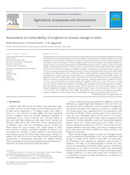Assessment on vulnerability of sorghum to climate change in India

It is important to analyse the impacts of climate change on target production system. However, it is more important to deduce possible adaptation strategies so that the research and developmental policies can be guided to meet the challenges of climate change. Impacts of climate change on the sorghum production system in India are analysed using InfoCrop-SORGHUM simulation model. In general, impact of climate change is projected to be more on winter crop in central (CZ) and south-central zones (SCZ), while in south-west zone (SWZ) the impacts are likely to be higher on monsoon crop. Climate change is projected to reduce monsoon sorghum grain yield to the tune of 14% in CZ and SWZ and by 2% in SCZ by 2020. Yields are likely to be affected even more in 2050 and 2080 scenarios. Climate change impacts on winter crop are projected to reduce yields up to 7% by 2020, up to 11% by 2050 and up to 32% by 2080. Impacts are projected to be more in SWZ region than in SCZ and CZ. But, the yield loss due to rise in temperature is likely to be offset by projected increase in rainfall. However, complete amelioration of yield loss beyond 2 °C rise may not be attained even after doubling of rainfall in south-central zone (SCZ) and in central zone (CZ). Results indicate that adaptation strategies like changing variety and sowing date can reduce the vulnerability of monsoon sorghum to about 10%, 2% and 3% in CZ, SCZ and SWZ regions in 2020 scenario. Adaptation strategies reduced the climate change impacts and vulnerability of winter crop to 1–2% in 2020, 3–8% in 2050 and 4–9% in 2080. This indicates that more low-cost adaptation strategies should be explored to further reduce the net vulnerability of sorghum production system in India.